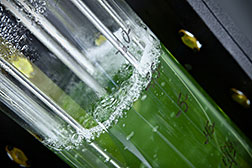- Number 454 |
- December 14, 2015
Humble bacterium could advance hydrogen as renewable fuel

Cyanothece 51142, shown here in a
bioreactor, has demonstrated that it is a
workhorse for natural hydrogen production.
A research team at DOE's Pacific Northwest National Laboratory has discovered that a common type of cyanobacterium, or blue-green algae, produces hydrogen, via photosynthesis, in two ways. The finding could lead to new approaches for hydrogen production as a renewable energy resource.
The PNNL team published the information, which pertains to a cyanobacterium known as Cyanothece 51142, in the Scientific Reports journal. Researchers know that 51142 makes hydrogen by drawing upon sugars that it has stored during growth. In this study, the PNNL team found something new—that the organism also draws on a second source of energy, using sunlight and water directly to make the chemical element.
In its experiment, the team set up Cyanothece 51142 in a bioreactor, limited the supply of nitrogen (which influences hydrogen production), and kept lights on for several weeks. The researchers used an array of high-tech equipment to yield sophisticated minute-by-minute profiles of the organism as it converted light energy to hydrogen. Further, the team "interrogated" the organism’s genes and proteins as they changed while the reactions occurred.
Scientists found that in addition to drawing upon its previously stored energy, the organism captures light and uses that energy to split water to create hydrogen in real time. As one component of the organism is creating energy by collecting light energy, another part is using that energy simultaneously to create hydrogen.
The discovery is another step toward advancing hydrogen as a clean energy source. "This organism can make lots of hydrogen, very fast; it's a viable catalyst for hydrogen production," says Hans Bernstein, a Linus Pauling distinguished postdoctoral fellow at PNNL. "The enzyme that makes the hydrogen needs a huge amount of energy. The real question is, what funds the energy budget for this important enzyme and then, how can we design and control it to create renewable fuels and to advance biotechnology?"
The research was supported by the DOE Office of Science (Biological and Environmental Research) and PNNL’s Laboratory Directed Research and Development program, which funds the Linus Pauling Distinguished Postdoctoral Fellowship Program.
More details—http://www.pnnl.gov/news/release.aspx?id=4234 and http://www.nature.com/articles/srep16004
[Greg Koller, 509.372.4864,
greg.koller@pnnl.gov]
